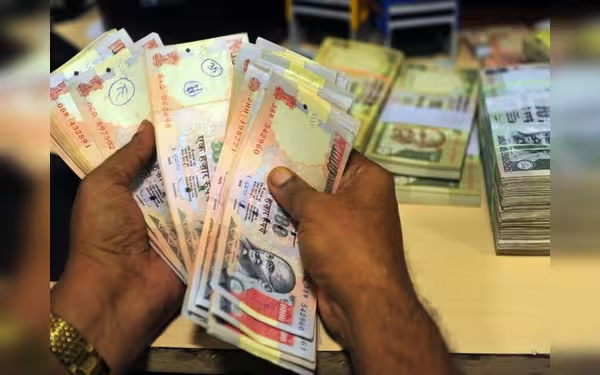Saturday, November 16, 2024 05:31 PM
Indian Rupee Hits Record Low Against US Dollar
- Indian rupee falls to 84.0725 against dollar.
- Foreign banks drive demand for US dollars.
- RBI interventions may provide future support.
 Image Credits: brecorder
Image Credits: brecorderThe Indian rupee has hit a record low against the US dollar, driven by foreign demand and equity outflows, raising concerns for the economy.
The Indian rupee has recently experienced a significant decline, reaching an all-time low against the US dollar. This drop is primarily attributed to the ongoing demand for dollars from foreign banks, which are likely purchasing the currency for their custodial clients. On Monday, the rupee fell to a record low of 84.0725 to the dollar, surpassing the previous low of 84.07 recorded just last Friday. This decline comes after the rupee had managed to stay around the 84 mark for over two months, thanks to regular interventions by the Reserve Bank of India (RBI).
Throughout October, the rupee has faced mounting pressure, largely due to substantial outflows from local equities. In fact, foreign investors have withdrawn approximately $8 billion over the last ten trading sessions. Additionally, the overall weakness in Asian currencies, driven by disappointment over China's economic stimulus measures, has further contributed to the rupee's struggles. On Monday, most Asian currencies were down by 0.1% to 0.3%, while the dollar index remained strong at 103, close to its two-month peak.
Traders have observed that local private and state-run banks are actively offering dollars, while large foreign banks are dominating the dollar bids. According to a trader at a foreign bank, the dollar-rupee pair is expected to fluctuate within a range of "83.95-84.20" in the near term. The trader also indicated that the rupee remains a "sell on uptick" if it moves rapidly within this range.
Despite the current challenges, there is a glimmer of hope for the rupee. Amit Pabari, managing director at FX advisory firm CR Forex, noted that the RBI's efforts to defend the currency, along with a potential easing of equity outflows, could provide some relief. This may help the rupee recover and rise above the 84 mark.
Moreover, traders are closely monitoring Brent crude oil prices, which fell to $78 per barrel on Monday. However, these prices have surged nearly 9% so far in October due to concerns about a wider conflict in the Middle East that could disrupt oil supplies. Additionally, Federal Reserve Governor Christopher Waller is scheduled to speak later in the day, and his comments may offer insights into the future direction of US policy rates.
The Indian rupee's recent decline highlights the complexities of the global financial landscape. As foreign demand for dollars continues to exert pressure on the local currency, it is essential for investors and traders to stay informed about market trends and central bank interventions. Understanding these dynamics can help individuals make more informed decisions in an ever-changing economic environment.













